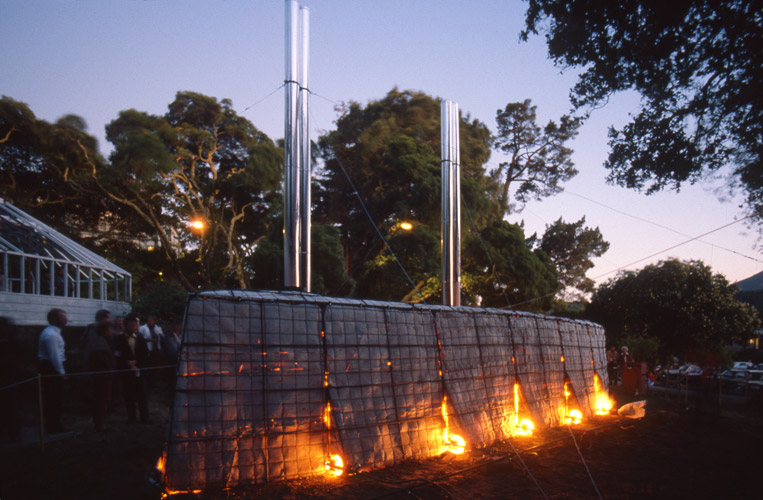Collision:
Lava Ship / Trellis Ship
Lava
Ship: 30 ft. (10.9 m), Trellis Ship: 40' ft. (12.2
m), steel, Clematis montana vines, landscaping, fused earth, San
Rafael, CA,
1984.
Left: night firing
of Lava Ship element
Middle: plan/detail
view of ship element intersection
Right: growth
of Clematis and landscaping after several years.
The
30 ft. long Lava Ship element was built of seven
tons of clay, mineral and organic mixture, applied over
a steel
armature
and
fired
on site using 12 burners
who's heat was distributed through the structure by an
internal downdraft system connected beneath the ground
to 4 external
25 ft.
high
flues, developed
by an
aerospace
engineer.
The 40 ft. steel Trellis Ship element,
planted
with
Clematis montana and earthen wave-like landscaping
was added after
the firing.
Of
significant interest in this work was the collision or
engagement of two dynamics, the intensity and rapid catalysis
of fire
and the lingering envelopment
of botanical grownth.The
selection of the white flowered Clematis vine was
both to bring a ghost-like quality to the work as well as
it's relatively |
agressive
growth ultimately encompassing both structures. Following
Mountain Kiln/Black
Orchid, 1982, this is the second kiln/furnace
work to engage botanical concepts and a precurssor to later
projects investigating the botanic origin of fossil fuels,
see Untitled
Earth Orchid, 1988, Oculus:
Dead Sea/Oil Field, 1989; Humboldt
Ship, 1989; Metabolism
and Mortality, 1992 and the video work: 51
Million BTU's... as well as installations using living plant
material such as Holocene Terrace, 1999; Original
Depositional Environment, 2001; and Seventh Climate
(Paradise Reconsidered),
2006. Carol Schemmerling,
was the project's consulting horticulturalist. |
Furnace
Projects, Constance
Lewallan;
Kiln
Projects: Material and Process Experiments in/of the Landscape, John
Roloff


